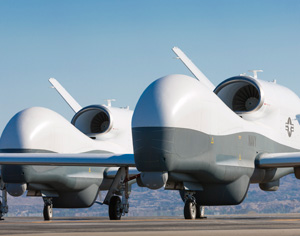Extending the use of its intelligence, surveillance, and reconnaissance (ISR) the US military is evaluating new capabilities of its Global Hawk platforms, including the US Navy’s MQ-4C Triton and Air Forces’ Block 30 MQ-4. The Triton recently demonstrated its ability to share the video with the navy’s P-8A Poseidon, as both platforms were airborne and far away from each other. The Air Forces’ Block 30 Global Hawk was also updated, to carry new mission payloads.
The exchange of live video between an MQ-4C Triton Remotely Piloted Aircraft System and P-8A Poseidon maritime warfare aircraft was demonstrated in flight on June 2, 2016. An MQ-4C Triton and P-8A Poseidon successfully exchanged full motion video for the first time in flight, via a Common Data Link (CDL), marking another interoperability step for the program. The test demonstrated Triton’s ability to track a target with its electro-optical/infrared camera to build situational awareness for a distant P-8 aircrew.
“In an operational environment, this would enable the P-8 aircrew to become familiar with a contact of interest and surrounding vessels well in advance of the aircraft’s arrival in station,” said Cmdr. Daniel Papp, Triton integrated program team lead. The MQ-4C Triton’s ability to perform persistent intelligence, surveillance, and reconnaissance within a range of 2,000 nautical miles will allow the P-8A aircraft to focus on their core missions.
Last week also marked the completion of Triton’s first heavyweight flight that will expand Triton’s estimated time on station significantly. Triton operated in the 20,000 foot altitude band in the heavyweight configuration for the first time and completed all test objectives. A second heavyweight flight on June 14 had Triton operating in the 30,000 foot altitude band. “The heavyweight envelope expansion work will enable Triton to realize its long dwell capability and become the unblinking eye for the fleet,” Papp added.
Triton is designed to fly missions of up to 24 hours at altitudes over 10 miles high, allowing the system to monitor two million square miles of ocean and littoral areas at a time. Since its first flight in 2013, Triton has flown more than 455 flight hours. The Navy will continue testing Triton at Patuxent River to prepare for its first planned deployment in 2018.
Another enhancement designed for the US Air Force Block 30 RQ-4 Global Hawk enables the platform to carry new mission payloads that were not originally designed for the Global Hawk.
“The IPA allows the RQ-4 to adapt and go beyond its current sensor capabilities. An example is the recent successful flight, for the first time, of an Air Force legacy system, the Senior Year Electro-Optical Reconnaissance System-2 (SYERS-2) intelligence gathering sensor, on the Global Hawk,” said Col. Darien Hammett, the Global Hawk program director.
With the success of the SYERS-2 flight, there are now plans to demonstrate the optical bar camera sensor, and fully integrate the next generation UTC Aerospace Systems MS-177 on the Global Hawk.
“The IPA allows vendors to use some or all of the 17 physical attachment points on the IPA, know how much power is available, and make crucial data exchanges with the aircraft. Everything needed to design, build and mount a sensor on a Global Hawk,” Hammett said. “Opening up the architecture of the air system will provide added sensor technology opportunities through increased competition, which is our goal.”
“This flexibility permits us to communicate to potential future interested vendors how to physically and electronically connect sensor platforms to the Global Hawk — allowing adaptability in payloads, increased range and the achievement of the highest National Imagery Interpretability Rating Scale available. With the development of the IPA, our Block 30 airframes will gain further capability in supporting future and current information gathering sensor systems availability.”
The current Global Hawk Block 30 aircraft is capable of carrying systems such as the Enhanced Integrated Sensor Suite, Airborne Signals Intelligence Payload. These electro-optical, infrared, radars, and signals intelligence sensors enable remotely piloted aircraft to detect movements, assist with humanitarian operations, and find the enemy.




















